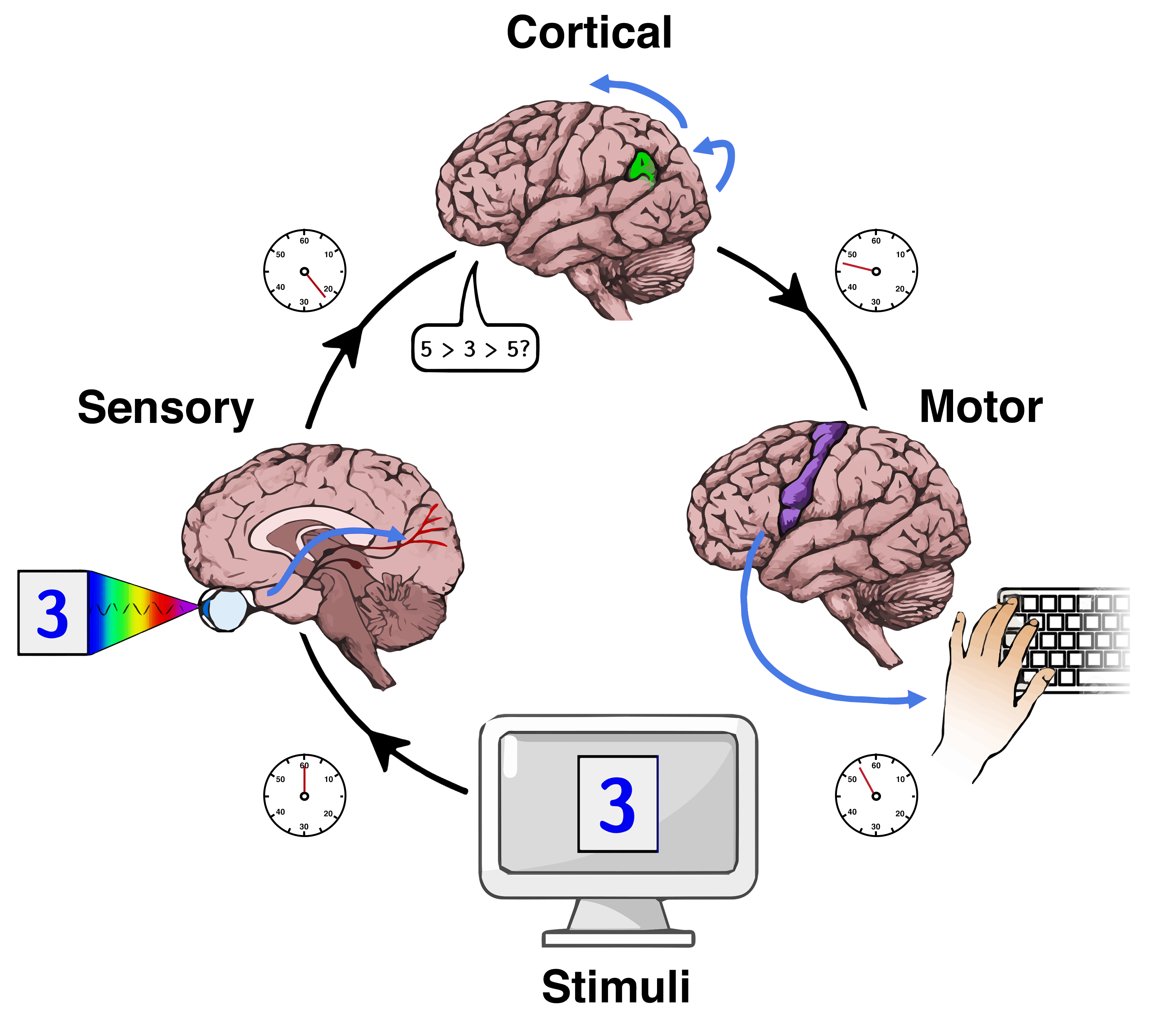|
Psychomotor Vigilance Task
A psychomotor vigilance task (PVT) is a sustained-attention, reaction-timed task that measures the consistency with which subjects respond to a visual stimulus. Research indicates increased sleep debt or sleep deficit correlates with deteriorated alertness, slower problem solving, declined psychomotor skills, and increased rate of false responses. Use of PVT tests was championed by David F. Dinges and popularized by its ease of scoring, simple metrics, and convergent validity. However, it was shown that motivation can counteract the detrimental effects of sleep loss for up to 36 hours. How it works The PVT is a simple task where the subject presses a button as soon as the light appears. The light will turn on randomly every few seconds for 5–10 minutes. The main measurement of this task is not to assess the reaction time (mental chronometry), but rather to see how many times the button is not pressed when the light is on . The purpose of the PVT is to measure sustained atte ... [...More Info...] [...Related Items...] OR: [Wikipedia] [Google] [Baidu] |
Attention
Attention is the behavioral and cognitive process of selectively concentrating on a discrete aspect of information, whether considered subjective or objective, while ignoring other perceivable information. William James (1890) wrote that "Attention is the taking possession by the mind, in clear and vivid form, of one out of what seem several simultaneously possible objects or trains of thought. Focalization, concentration, of consciousness are of its essence." Attention has also been described as the allocation of limited cognitive processing resources. Attention is manifested by an attentional bottleneck, in terms of the amount of data the brain can process each second; for example, in human vision, only less than 1% of the visual input data (at around one megabyte per second) can enter the bottleneck, leading to inattentional blindness. Attention remains a crucial area of investigation within education, psychology, neuroscience, cognitive neuroscience, and neuropsychology. ... [...More Info...] [...Related Items...] OR: [Wikipedia] [Google] [Baidu] |
Motivation
Motivation is the reason for which humans and other animals initiate, continue, or terminate a behavior at a given time. Motivational states are commonly understood as forces acting within the agent that create a disposition to engage in goal-directed behavior. It is often held that different mental states compete with each other and that only the strongest state determines behavior. This means that we can be motivated to do something without actually doing it. The paradigmatic mental state providing motivation is desire. But various other states, such as beliefs about what one ought to do or intentions, may also provide motivation. Motivation is derived from the word 'motive', which denotes a person's needs, desires, wants, or urges. It is the process of motivating individuals to take action in order to achieve a goal. The psychological elements fueling people's behavior in the context of job goals might include a desire for money. Various competing theories have been proposed co ... [...More Info...] [...Related Items...] OR: [Wikipedia] [Google] [Baidu] |
Psychological Testing
Psychological testing is the administration of psychological tests. Psychological tests are administered by trained evaluators. A person's responses are evaluated according to carefully prescribed guidelines. Scores are thought to reflect individual or group differences in the construct the test purports to measure. The science behind psychological testing is psychometrics. Psychological tests According to Anastasi and Urbina, psychological tests involve observations made on a "carefully chosen ''sample'' mphasis authorsof an individual's behavior." A psychological test is often designed to measure unobserved constructs, also known as latent variables. Psychological tests can include a series of tasks or problems that the respondent has to solve. Psychological tests can include questionnaires and interviews, which are also designed to measure unobserved constructs. Questionnaire- and interview-based scales typically differ from psychoeducational tests, which ask for a responden ... [...More Info...] [...Related Items...] OR: [Wikipedia] [Google] [Baidu] |
Meditation
Meditation is a practice in which an individual uses a technique – such as mindfulness, or focusing the mind on a particular object, thought, or activity – to train attention and awareness, and achieve a mentally clear and emotionally calm and stable state. Meditation is practiced in numerous religious traditions. The earliest records of meditation (''dhyana'') are found in the Upanishads, and meditation plays a salient role in the contemplative repertoire of Jainism, Buddhism and Hinduism. Since the 19th century, Asian meditative techniques have spread to other cultures where they have also found application in non-spiritual contexts, such as business and health. Meditation may significantly reduce stress, anxiety, depression, and pain, and enhance peace, perception, self-concept, and well-being. Research is ongoing to better understand the effects of meditation on health (psychology, psychological, neurology, neurological, and cardiovascular) and other areas. Etymol ... [...More Info...] [...Related Items...] OR: [Wikipedia] [Google] [Baidu] |
Cognitive Test
Cognitive tests are assessments of the cognitive capabilities of humans and other animals. Tests administered to humans include various forms of IQ tests; those administered to animals include the mirror test (a test of visual self-awareness) and the T maze test (which tests learning ability). Such study is important to research concerning the philosophy of mind and psychology, as well as determination of human and animal intelligence. Modern cognitive tests originated through the work of James McKeen Cattell who coined the term "mental tests". They followed Francis Galton's development of physical and physiological tests. For example, Galton measured strength of grip and height and weight. He established an "Anthropometric Laboratory" in the 1880s where patrons paid to have physical and physiological attributes measured. Galton's measurements had an enormous influence on psychology. Cattell continued the measurement approach with simple measurements of perception. Cattell's tests ... [...More Info...] [...Related Items...] OR: [Wikipedia] [Google] [Baidu] |
International Space Station
The International Space Station (ISS) is the largest modular space station currently in low Earth orbit. It is a multinational collaborative project involving five participating space agencies: NASA (United States), Roscosmos (Russia), JAXA (Japan), ESA (Europe), and CSA (Canada). The ownership and use of the space station is established by intergovernmental treaties and agreements. The station serves as a microgravity and space environment research laboratory in which scientific research is conducted in astrobiology, astronomy, meteorology, physics, and other fields. The ISS is suited for testing the spacecraft systems and equipment required for possible future long-duration missions to the Moon and Mars. The ISS programme evolved from the Space Station ''Freedom'', a 1984 American proposal to construct a permanently crewed Earth-orbiting station, and the contemporaneous Soviet/Russian '' Mir-2'' proposal from 1976 with similar aims. The ISS is the ninth space station to ... [...More Info...] [...Related Items...] OR: [Wikipedia] [Google] [Baidu] |
Mental Chronometry
Mental chronometry is the scientific study of processing speed or reaction time on cognitive tasks to infer the content, duration, and temporal sequencing of mental operations. Reaction time (RT; sometimes referred to as "response time") is measured by the elapsed time between stimulus onset and an individual's response on elementary cognitive tasks (ETCs), which are relatively simple perceptual-motor tasks typically administered in a laboratory setting. Mental chronometry is one of the core methodological paradigms of human experimental psychology, experimental, cognitive psychology, cognitive, and differential psychology, but is also commonly analyzed in Physiological psychology, psychophysiology, cognitive neuroscience, and behavioral neuroscience to help elucidate the biological mechanisms underlying perception, attention, and decision-making in humans and other species. Mental chronometry uses measurements of elapsed time between sensory stimulus onsets and subsequent behavi ... [...More Info...] [...Related Items...] OR: [Wikipedia] [Google] [Baidu] |
Convergent Validity
Convergent validity, for human cognition, especially within sociology, psychology, and other behavioral sciences, refers to the degree to which two measures that theoretically should be related, are in fact related. Convergent validity, along with discriminant validity, is a subtype of construct validity. Convergent validity can be established if two similar constructs correspond with one another, while discriminant validity applies to two dissimilar constructs that are easily differentiated. Campbell and Fiske (1959) developed the Multitrait-Multimethod Matrix to assess the construct validity of a set of measures in a study. The approach stresses the importance of using both discriminant and convergent validation techniques when assessing new tests. In other words, in order to establish construct validity, you have to demonstrate both convergence and discrimination. Evaluation/application Convergent validity can be estimated using correlation coefficients. A successful evaluati ... [...More Info...] [...Related Items...] OR: [Wikipedia] [Google] [Baidu] |
Stimulus (psychology)
In psychology Psychology is the scientific study of mind and behavior. Psychology includes the study of conscious and unconscious phenomena, including feelings and thoughts. It is an academic discipline of immense scope, crossing the boundaries betwe ..., a stimulus is any object or event that elicits a sensory or behavioral response in an organism. In this context, a distinction is made between the ''distal stimulus'' (the external, perceived object) and the ''proximal stimulus'' (the stimulation of sensory organs). *In perceptual psychology, a stimulus is an energy change (e.g., light or sound) which is registered by the senses (e.g., vision, hearing, taste, etc.) and constitutes the basis for perception. *In behavioral psychology (i.e., classical conditioning, classical and operant conditioning, operant conditioning), a stimulus constitutes the basis for behavior. The stimulus–response model emphasizes the relation between stimulus and behavior rather than an anim ... [...More Info...] [...Related Items...] OR: [Wikipedia] [Google] [Baidu] |
David F
David (; , "beloved one") (traditional spelling), , ''Dāwūd''; grc-koi, Δαυΐδ, Dauíd; la, Davidus, David; gez , ዳዊት, ''Dawit''; xcl, Դաւիթ, ''Dawitʿ''; cu, Давíдъ, ''Davidŭ''; possibly meaning "beloved one". was, according to the Hebrew Bible, the Kings of Israel and Judah, third king of the Kingdom of Israel (united monarchy), United Kingdom of Israel. In the Books of Samuel, he is described as a young shepherd and Lyre, harpist who gains fame by slaying Goliath, a champion of the Philistines, in southern Canaan. David becomes a favourite of Saul, the first king of Israel; he also forges David and Jonathan, a notably close friendship with Jonathan (1 Samuel), Jonathan, a son of Saul. However, under the paranoia that David is seeking to usurp the throne, Saul attempts to kill David, forcing the latter to go into hiding and effectively operate as a fugitive for several years. After Saul and Jonathan are both killed in battle against the Philistin ... [...More Info...] [...Related Items...] OR: [Wikipedia] [Google] [Baidu] |
False Positives And False Negatives
A false positive is an error in binary classification in which a test result incorrectly indicates the presence of a condition (such as a disease when the disease is not present), while a false negative is the opposite error, where the test result incorrectly indicates the absence of a condition when it is actually present. These are the two kinds of errors in a binary test, in contrast to the two kinds of correct result (a and a ). They are also known in medicine as a false positive (or false negative) diagnosis, and in statistical classification as a false positive (or false negative) error. In statistical hypothesis testing the analogous concepts are known as type I and type II errors, where a positive result corresponds to rejecting the null hypothesis, and a negative result corresponds to not rejecting the null hypothesis. The terms are often used interchangeably, but there are differences in detail and interpretation due to the differences between medical testing and statist ... [...More Info...] [...Related Items...] OR: [Wikipedia] [Google] [Baidu] |
.jpg)



